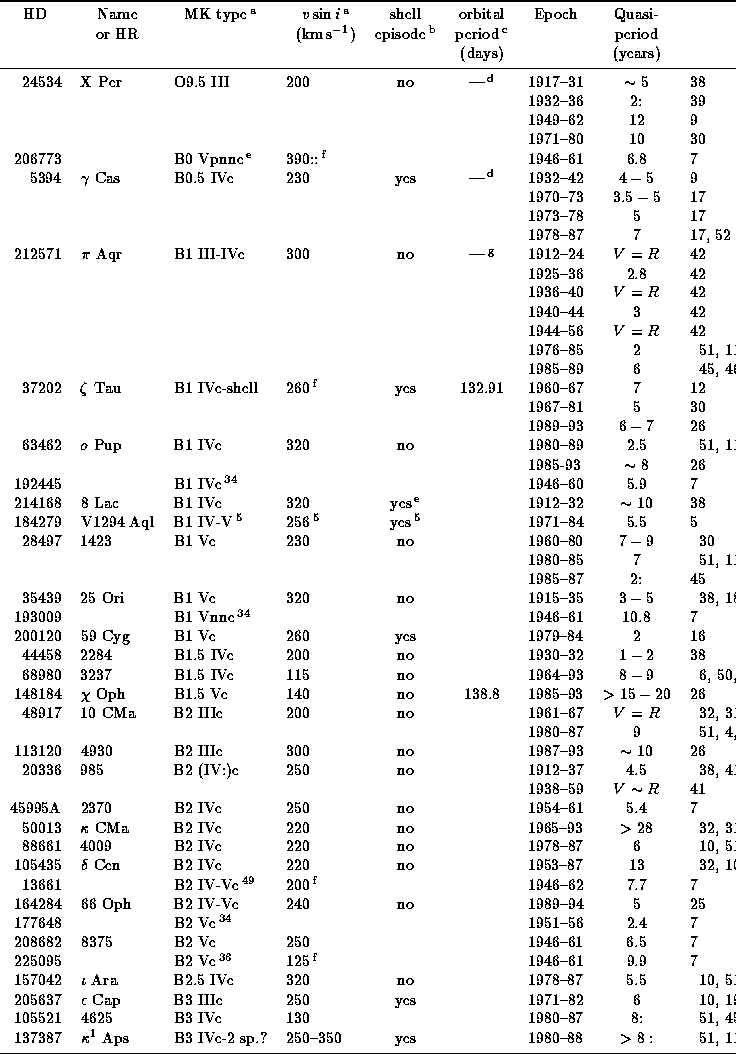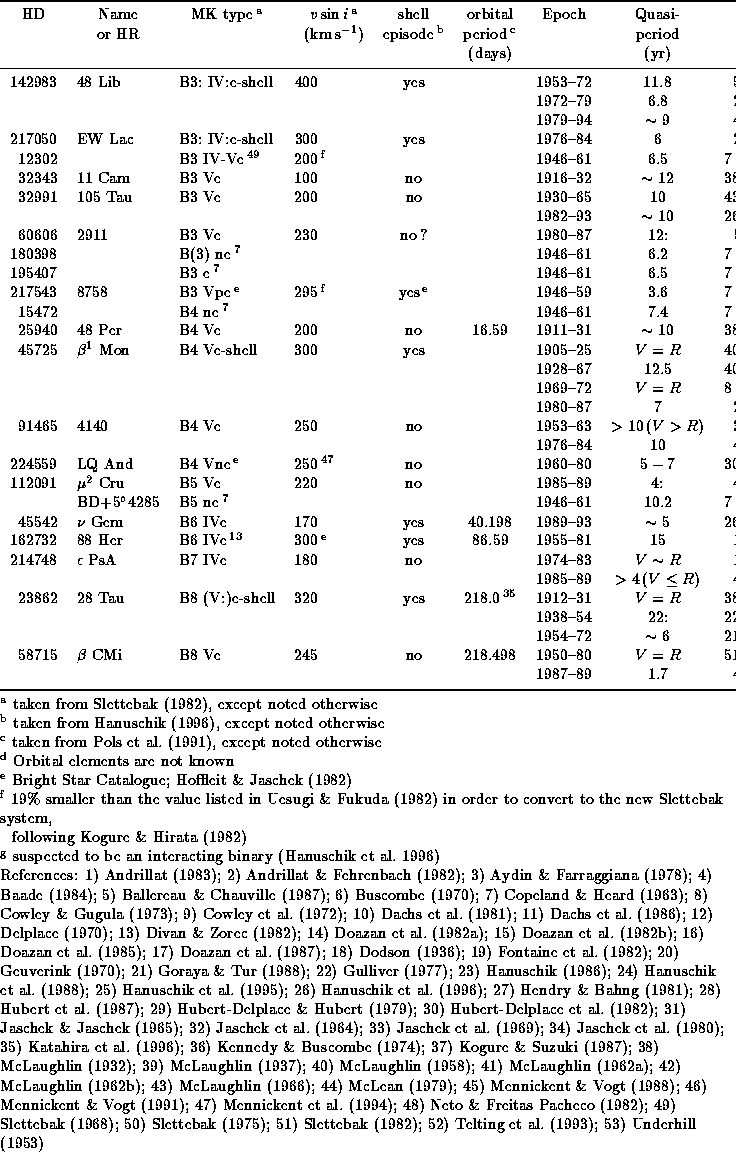


Next: References
Up: Abstract
Previous: 5 Observational tests of
We have examined how the weak-line force and
the rotational deformation of the star affect the confinement of
one-armed oscillations in near-Keplerian discs of Be stars.
For simplicity, we assumed an isothermal disc with
 and
and
 ,
where
,
where  and
and  are the disc temperature
and the effective temperature of the star, respectively,
and
are the disc temperature
and the effective temperature of the star, respectively,
and  the density gradient index of the disc.
The advective motion in the unperturbed disc was neglected.
We took into account the effect of rotation
by including the quadrupole contribution to the potential
around the rotationally-distorted central star.
For the radiative force due to
an ensemble of optically thin lines,
we adopted the parametric form proposed by
Chen & Marlborough (1994).
the density gradient index of the disc.
The advective motion in the unperturbed disc was neglected.
We took into account the effect of rotation
by including the quadrupole contribution to the potential
around the rotationally-distorted central star.
For the radiative force due to
an ensemble of optically thin lines,
we adopted the parametric form proposed by
Chen & Marlborough (1994).
Based on these assumptions, we have numerically studied
the linear, isothermal m=1 eigenmodes
confined to the inner part of the disc.
Examining the eigenvalue problem for a wide range of parameters
characterizing the effects of rotation and radiation,
we have derived the following conclusions:
- The present study strongly suggests a scenario
in which the mechanism that causes the confinement of
one-armed oscillations in early-type Be stars
is different from that in late-type Be stars.
In late-type Be stars, the confinement of oscillations
in the inner part of the disc
occurs because of the deviation from the point-mass potential
around the rotationally-deformed star.
The radiative effect plays a minor role in these stars.
On this point, we confirm the conclusions obtained by
Papaloizou et al. (1992) and Savonije & Heemskerk (1993).
In early-type Be stars, however,
it is the weak-line force
that mainly contributes to the confinement.
For these stars, the rotational effect plays a minor role.
- The period of a one-armed eigenmode confined
to the inner part of the disc is sensitive to
the value of the parameter characterizing
the effect of rotation or radiation.
This sensitiveness, together with the period range
of observed V/R variations, enables us to place
rather narrow constraints on the parameter values.
In particular, the distribution of the V/R periods expected from
the hybrid scenario agrees well with the distribution of
the observed V/R periods.
Furthermore, this scenario predicts that
the periods of V/R variations of early-type Be stars
have little correlation with the rotation parameter of
the central star,
whereas, in late-type Be stars,
a star with smaller rotation parameter exhibits
either a V/R variation with a longer period or no V/R variation
if the star rotates too slowly.
Observational tests of this prediction are desired.
- The characteristics of the eigenfunction
are very similar in early- and late-type Be stars,
in spite of the fact that the mechanism that causes
the confinement of the mode is different.
They agree well with the periodicity and line-profile variability
of the observed V/R variations.
In the formulation of the current problem,
we adopted the parametric form of the radiative force
due to an ensemble of optically thin lines,
and assumed that the radiative force decreases,
with increasing radius,
less rapidly than the gravity.
Some of the above conclusions have been derived
on the basis of this assumption.
If the radiative force decreases with radius
more rapidly than the gravity,
it never contributes to the confinement of the m=1 oscillations.
We need, then, another unknown mechanism for the confinement
of oscillations in discs of early-type Be stars.
It is, therefore, highly desirable to derive
a more detailed form of the radiative force due to
an ensemble of optically thin lines.
acknowledgements:
The author thanks H.F. Henrichs for
careful reading of the manuscript
and stimulating discussions
based on which Sect. 5 was written.
The author also thanks
the Astronomical Institute 'Anton Pannekoek'
for their warm hospitality.
This work was partially supported by a grant from
Hokkai-Gakuen Educational Foundation.
Appendix: List of stars showing long-term V/R variations
In their statistical study of long-term V/R variations,
Hirata & Hubert-Delplace (1981) used a total of 28 sample stars
collected from McLaughlin (1932, 1958),
Copeland & Heard (1963), and
Hubert-Delplace et al. (1982).
Later, Mennickent & Vogt (1991) statistically analyzed short- and
long-term V/R variations based on their plates for southern Be stars
and data collected by a literature search.
Among their sample stars, a total of 29 stars show long-term V/R variations.
Since the sample stars of Hirata & Hubert-Delplace (1981) and
Mennickent & Vogt (1991) overlap only partly,
we combined the data for these two sets
to make a larger data set
[we have missed data for four stars in the sample of
Hirata & Hubert-Delplace (1981)].
We added data for some additional stars from the literature.
The results are shown in Table 1.
Table 1 also includes
information on shell episodes and binarity
for individual stars, which were
taken mainly from Hanuschik (1996) and Pols et al. (1991), respectively.
Many stars studied by Copeland & Heard (1963) are
fainter than  ,
for which we could not find recent studies.
We consider this table
as not exhaustive but rather fairly representative,
except for stars later than B4,
for which there are not sufficient data available.
We also note that about 1/3 of the Be stars have not shown
long-term V/R variations
(Copeland & Heard 1963; Mennickent & Vogt 1991).
,
for which we could not find recent studies.
We consider this table
as not exhaustive but rather fairly representative,
except for stars later than B4,
for which there are not sufficient data available.
We also note that about 1/3 of the Be stars have not shown
long-term V/R variations
(Copeland & Heard 1963; Mennickent & Vogt 1991).

: Periods of long-term V/R variations for 53 stars

: (Continued)



Next: References
Up: Abstract
Previous: 5 Observational tests of
Atsuo Okazaki
平成9年3月15日 (土), 午後 1時19分3秒
 and
and
 ,
where
,
where  and
and  are the disc temperature
and the effective temperature of the star, respectively,
and
are the disc temperature
and the effective temperature of the star, respectively,
and  the density gradient index of the disc.
The advective motion in the unperturbed disc was neglected.
We took into account the effect of rotation
by including the quadrupole contribution to the potential
around the rotationally-distorted central star.
For the radiative force due to
an ensemble of optically thin lines,
we adopted the parametric form proposed by
Chen & Marlborough (1994).
the density gradient index of the disc.
The advective motion in the unperturbed disc was neglected.
We took into account the effect of rotation
by including the quadrupole contribution to the potential
around the rotationally-distorted central star.
For the radiative force due to
an ensemble of optically thin lines,
we adopted the parametric form proposed by
Chen & Marlborough (1994).
 ,
for which we could not find recent studies.
We consider this table
as not exhaustive but rather fairly representative,
except for stars later than B4,
for which there are not sufficient data available.
We also note that about 1/3 of the Be stars have not shown
long-term V/R variations
(Copeland & Heard 1963; Mennickent & Vogt 1991).
,
for which we could not find recent studies.
We consider this table
as not exhaustive but rather fairly representative,
except for stars later than B4,
for which there are not sufficient data available.
We also note that about 1/3 of the Be stars have not shown
long-term V/R variations
(Copeland & Heard 1963; Mennickent & Vogt 1991).

